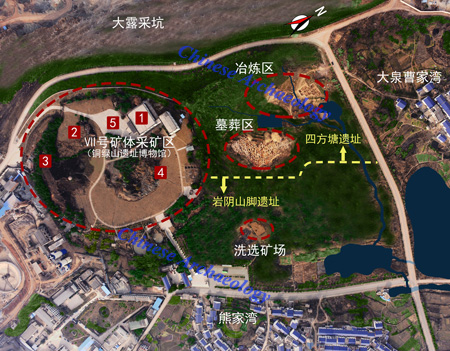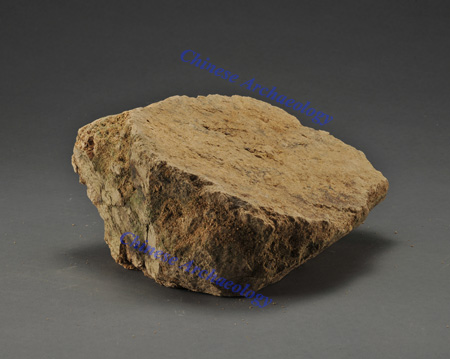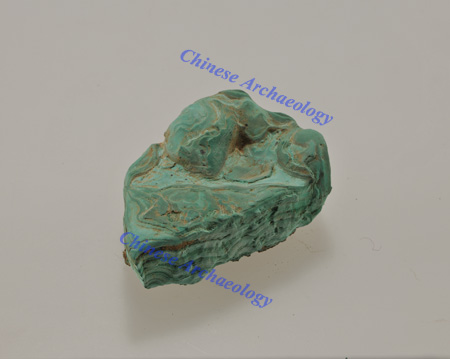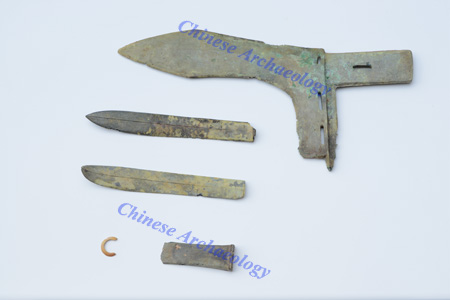Miners’ cemetery of the Zhou Dynasty found at Tonglushan, Hubei
From:Chinese Archaeology NetWriter:Date:2016-05-17
From the November 2014 to the November 2015, the archaeological team operated by the Hubei Provincial Institute of Archaeology and Cultural Relics conducted the excavation at the cemetery near Sifangtang site in Hubei Provence where the Tonglushan ancient mine was situated to the west. The location, layout, dating and funeral goods indicate that this cemetery might have been constructed for miners who once worked at Tonglushan mine. This is the first cemetery ever found which is related to mining.
Aerial photo of the Sifangtang site
The excavation covers an area of 2275 square meters and 132 tombs in total were excavated. Among them, there were 3 tombs belonging to the Late West Zhou Dynasty, 118 belonging to the Spring and Autumn period, and 11 modern tombs. Grave goods recovered from the cemetery include copper, ceramics, jade and stone artifacts, 170 pieces (sets) in total. Tombs of the Zhou Dynasties were shaft earth (rock) tombs, with similar size in order. Most of these tombs were arranged along with northwest-southeast axis while only a few were aligned from southwest to northeast.

The plan of No. 7 Tonglushan mine which showed the industry process
91 tombs of Spring and Autumn period were found buried with coffins. Only in three of them, human teeth were recovered. Judging from the location of teeth, skeletons probably headed to the same direction as tombs. Tomb M34 was the largest one. However, nothing was found inside.
According to funeral furniture, two types of tombs can be found. The first type contained one outer coffin and one inner coffin, whose scales were relatively larger than others. There were 5 tombs in this category. The second type included 116 tombs which were buried with only one coffin, or no coffin at all. Amongst all tombs, 37 were built in with side niches and 3 with head niches. Funeral goods were recovered in 63 tombs, most of which were daily items. Ceramics were discovered in 36 tombs. Ceramic sets comprised of li tripod (drinking vessel), yu vessel, and dou (pedestal dish) were present in 5 tombs. Other sets comprised of li tripod, dou, guan (jar) or li, dou, bo (bowl) or bronze ding vessel, pottery yu vessel, dou were respectively found in 5 tombs. In the remaining tombs, only one or two items were found. Bronze weapons along with tools and decorations were found in 20 tombs as many as 14 items in one tomb while only 1 item in the tomb. In one tomb, jade artifacts were found whereas in other 4 tombs iron ore were recovered within the side niches. Whetstone and lithic molar were found in 2 tombs.

Stone anvil unearthed from tomb M37
In that tombs at the Sifangtang site were of lower ranked tombs in similar size and good arrangement, this cemetery was obviously different from family cemetery of the East Zhou Dynasty. This cemetery, roughly dating back to the Late Spring and Autumn period, was chronologically similar to five locations of Tonglushan mine sites No.VII. Types of funeral goods cover a wide range and have clear functions. In addition to copper axes and awls, and stone anvil, those tools which have been collected in previous excavations, several artifacts for daily use were discovered for the first time including ding tripod, ge (knife), pi (knife), zu (arrowhead), small knife and band hook. Especially, we found that there were tombs buried with funeral goods such as iron ore and malachite, indicating their close relation to mining. Referring to its location, the cemetery seemed associated with the No. VII location of the Tonglushan mine.

Malachite unearthed from tomb M54

Dagger, chisel and scraper made of bronze and jadeware unearthed from tomb M88
So far the study of the Sifangtang cemetery has displayed great importance regarding our understanding of the ancient mining industry.
First and foremost, the cemetery was the first ever discovery in the 40- years excavation in the Tonglushan mining site. It is also the very first discovery in the history of mining archaeology. It is impressive that cultural features, chronological remarks, tomb structure and funeral goods were preserved in such a good condition.
Secondly, in addition to the cemetery, previous findings of miners’ feet prints, mine pits and smelting workshops clearly illustrate the copper mine production process at Tonglushan, rendering valuable information on technology, management and other aspects of mining industry in the East Zhou Dynasty.
Thirdly, a variety of people were buried in the cemetery regarding their social status and occupations. It is thus vital to cast light upon the labour resource and management of miners in ancient China, during the Spring and Autumn period in particular.
Fourthly, the local Yangyue culture had profound influences over the cemetery. Gradually, factors belonging to the Chu culture became dominating, probably indicating the rising power of the Chu state and proving clues to seek for the clans of miners there.
Last but not least, scientific analyses have been employed to assess smelting wastes and bronze artifacts. Their results will definitely help us to decode the development of mining technology at the Tonglushan site as well as Chu state during the Spring and Autumn period. (Translator: Dong Ningning)

